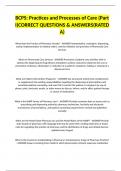BCPS: Practices and Processes of Care (Part
I)CORRECT QUESTIONS & ANSWERS(RATED
A)
What does the Practice of Pharmacy include? - ANSWER Interpretation, evaluation, dispensing,
and/pr implementation of medical orders, and the initiation and provision of Pharmacist Care
Services
What are Pharmacist Care Services - ANSWER Provisions of patient care activities with or
without the dispensing of drug/devices intended to achieve outcomes related to the cure or
prevention of disease, elimination or reduction of a patient's symptoms, halting or slowing of a
disease process
What are Patient Intervention Programs? - ANSWER Any structured activity that complements
or supplements the existing responsibilities regarding the dispensing of prescriptions and
associated patient counseling, and uses PHI to contact the patient or caregivers by way of
phone, print, electronic media, or other means to discuss, inform, and/or affect patient therapy
or choice of medications
What is the NABP Survey of Pharmacy Law? - ANSWER Provides summary data on issues such as
prescribing and dispensing authority, pharmacy technicians, facsimile and electronic
transmission of prescriptions, and patient counseling requirements; revised and published
annually
What are the Model State Pharmacy Act and the Model Rules of the NABP? - ANSWER Provide
state boards of pharmacy with language that may be used when creating state laws or board
rules for regulating the practice of pharmacy and the distribution of drugs and related devices;
updated every August
What is the Council on Credentialing in Pharmacy's Contemporary Scope of Pharmacy Practice?
- ANSWER Scope is evolving from model in which pharmacists primarily supervise medication
, distribution and counsel patients to a model in which pharmacists play an expanded, team-
based clinical role of providing patient-centered MTM, health improvement, and disease
prevention services
What is the Joint Commission of Pharmacy Practitioners' (JCCP's) Vision for Pharmacy Practice? -
ANSWER Patients achieve optimal health and medication outcomes with pharmacists as
essential and accountable providers within patient-centered, team-based healthcare.
What are examples of pharmacist recognition of expanded services? - ANSWER - CDTM
- Licensure as clinicians (i.e., New Mexico's Pharmacist Clinician)
- Legislation (i.e., North Carolina's Clinical Pharmacist Practitioner and California's Advanced
Practice Pharmacist)
In the ambulatory care setting, who has the ultimate responsibility for the patient's ability to
obtain and use any drug, products, or equipment in the drug therapy plan? - ANSWER The
pharmacist...
What are the structural elements for quality pharmaceutical care? - ANSWER 1. Knowledge,
skill, and function of personnel
2. A system for data collection, documentation, and transfer of information
3. Effective workflow
4. References, resources, and equipment
5. Good communication skills
6. Commitment to quality improvement and assessment procedures
What areas should pharmacist have knowledge and skills in? - ANSWER Patient assessment,
clinical information, communication, adult teaching and learning principles, and psychosocial
aspects of care
, Who/what does personnel include? - ANSWER Pharmacists, technicians, automation, and
technology
What did the Medicare Modernization Act of 2003 do? - ANSWER Required Medicare Part D to
provide an MTM program as part of its drug benefit program offered to Medicare beneficiaries.
What is Medication Therapy Management (MTM)? - ANSWER A distinct service or group of
services that optimizes therapeutic outcomes for individual patients; services are independent
of, but can occur in conjunction with, the provision of a medication product; created in
collaboration with 11 national pharmacy organizations
What are the CMS Goals of MTM (3)? - ANSWER 1. Optimize therapeutic outcomes through
improved medication use
2. Reduce the risk of adverse events and drug interactions
3. Improve medication adherence
What are the CMS enrollment requirements of MTM program for the 2019 plan year? -
ANSWER - Plans must auto-enroll targeted beneficiaries who meet the eligibility criteria, and
they are considered enrolled unless they decline enrollment (opt-out method)
- Plans must target beneficiaries for enrollment at least quarterly during each plan year
- Plans are expected to use more than one approach, when possible, to reach eligible
beneficiaries
What is the maximum number of chronic diseases a Part D plan sponsor may require for
targeted enrollment? - ANSWER Three
How many chronic diseases do most plans require for eligibility? - ANSWER Two or three
Plans that specify which chronic disease apply must select at least how many of the nine distinct
core chronic diseases? - ANSWER Five




